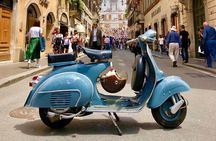
No expiration date
Easy refund
Free exchange
Easy booking
Exploring Rome on a Vintage Vespa Adventure Journey
$142.01
This is an experience gift voucher. The recipient will book the experience after
they redeem the gift voucher.
Overview
Exploring Rome in a vintage vespa with a local guide offers an exclusive and intimate glimpse into the city's heart. This iconic Italian vespa, perfect for the narrow Roman streets, allows access to hidden spots and famous landmarks, making every moment feel like a step back in time. Paired with the insider knowledge of a professional local guide, this tour promises a personalized and unforgettable journey through Rome's rich history and vibrant culture, all from the unique perspective of a timeless classic.
—
Exploring Rome on a Vintage Vespa Adventure Journey
Tour guide
Language: English
Human tour guide
Duration: 3 hours
Availability depends on seasonality and number of participants. Bookings can not be made for the same day. Please read our TnC’s.
When giving as a gift, your recipient can choose a date at their convenience during a booking process. Otherwise, you can choose one after checkout and voucher redemption.
When giving as a gift, your recipient can choose a date at their convenience during a booking process. Otherwise, you can choose one after checkout and voucher redemption.
Check available dates by emailing us at [email protected]
- Licensed Guide
- Snacks
- In person guide English, Spanish, Italian
- Soda/Pop
- Dinner
Meeting point
I will be waiting in the front of restaurant Osteria di Pasquino
Return details
I will be waiting in the front of restaurant Osteria di Pasquino
-
PantheonThe Pantheon of Agrippa, also known as the Roman Pantheon, is one of the architectural masterpieces of the Italian capital. It is the best preserved building of ancient Rome. Completed in 126 AD, it was a Roman temple with a striking oculus that is the main source of natural light for the building.
-
Piazza del PopoloPiazza del Popolo is a large urban square in Rome. The name in modern Italian literally means "People's Square", but historically it derives from the poplars (populus in Latin, pioppo in Italian) after which the church of Santa Maria del Popolo, in the northeast corner of the piazza, takes its name.
-
Piazza NavonaPiazza Navona, in ancient Rome, was the Stadium of Domitian, which was built by Emperor Domitian in 85 and restored by Alexander Severus in the 3rd century. It was 265 meters long, 106 meters wide and could accommodate 30,000 spectators
-
Trevi FountainThe Trevi Fountain (Italian: Fontana di Trevi) is an 18th-century fountain in the Trevi district in Rome, Italy, designed by Italian architect Nicola Salvi and completed by Giuseppe Pannini in 1762[1] and several others. Standing 26.3 metres (86 ft) high and 49.15 metres (161.3 ft) wide,[2] it is the largest Baroque fountain in the city and one of the most famous fountains in the world.
-
Campo De' FioriBetween the lively Piazza Navona and the aristocratic Piazza Farnese, where, since 1874, the palace of the same name is the seat of the French Embassy, stands one of the many treasures of the city, a place which, with its picturesque and characteristic market, represents the typical scenario of old Rome. Campo de' Fiori is one of the Capital's most particular and loved areas. It is the ideal context for a pleasant walk among its historic wooden stalls where you can buy, always fresh flowers, fruit, meat, and fish, Campo de' Fiori, however, also has a dark side: in the square, you could witness spectacular executions, among which the impressive one of the monk and philosopher Giordano Bruno, who, accused of heresy, was burned alive on 17 February 1600
-
Piazza Di SpagnaThe Spanish Steps (Italian: Scalinata di Trinità dei Monti) in Rome, Italy, climb a steep slope between Piazza di Spagna at the base and Piazza Trinità dei Monti, dominated by the Trinità dei Monti church, at the top. The monumental stairway of 135 steps[1] is linked with the Trinità dei Monti church, under the patronage of the Bourbon kings of France, at the top of the steps and the Spanish Embassy to the Holy See in the Palazzo Monaldeschi at the bottom of the steps. The stairway was designed by the architects Francesco de Sanctis and Alessandro Specchi.
-
Piramide CestiaThe pyramid of Cestius is an ancient Roman pyramid in Rome, Italy, near the Porta San Paolo and the Protestant Cemetery. It was built in the style of the Nubian pyramids as a tomb for Gaius Cestius, a member of the Epulones religious corporation. It stands at a fork between two ancient roads, the Via Ostiensis and another road that ran west to the Tiber along the approximate line of the modern Via Marmorata. Due to its incorporation into the city's fortifications, it is today one of the best-preserved ancient buildings in Rome.
- Located between Via del Corso and Via dei Fori Imperiali, Piazza Venezia derives its shape from the remaking of the area, which took place at the turn of the 19th and 20th centuries, for the construction of the Monumento a Vittorio Emanuele II. Also known as Altare della Patria, the huge monument was started in 1885 by Giuseppe Sacconi and finished by Gaetano Koch, Manfredo Manfredi and Pio Piacentini in 1911. Its architectural structure represents an ideal ascending path that, through stairways and terraces enriched by sculptural groups and bas-reliefs, rises up to the imposing colonnaded portico surmounted by bronze chariots, allegories of the Unity of the Homeland and Freedom. In 1921, in the crypt designed by Armando Brasini, the body of the Unknown Soldier was buried. (pass by)
-
Circo MassimoThe Circus Maximus is an ancient Roman chariot-racing stadium and mass entertainment venue in Rome, Italy. In the valley between the Aventine and Palatine hills, it was the first and largest stadium in ancient Rome and its later Empire. It measured 621 m (2,037 ft) in length and 118 m (387 ft) in width and could accommodate over 150,000 spectators. In its fully developed form, it became the model for circuses throughout the Roman Empire. The site is now a public park for event and festivals
-
Terrazza del GianicoloThe Janiculum, occasionally known as the Janiculan Hill, is a hill in western Rome, Italy. Although it is the second-tallest hill (the tallest being Monte Mario) in the contemporary city of Rome, the Janiculum does not figure among the proverbial Seven Hills of Rome, being west of the Tiber and outside the boundaries of the ancient city. The Janiculum also houses a Baroque fountain built by Pope Paul V in the late 17th century, the Fontana dell'Acqua Paola
- In Rome's Regal period (753–509 BC), the area across the Tiber belonged to the Etruscans: the Romans named it Ripa Etrusca (Etruscan bank). Rome conquered it to gain control of and access to the river from both banks, but was not interested in building on that side of the river. In fact, the only connection between Trastevere and the rest of the city was a small wooden bridge called the Pons Sublicius Nowadays, Trastevere maintains its character thanks to its narrow cobbled streets lined by ancient houses. At night, natives and tourists alike flock to its many pubs and restaurants,[5] but much of the original character of Trastevere remains. (pass by)
-
St. Peter's BasilicaSaint Peter's Square is a large plaza located directly in front of St. Peter's Basilica in Vatican City, the papal enclave in Rome, directly west of the neighborhood (rione) of Borgo. Square and basilica are named after Saint Peter, an apostle of Jesus whom Catholics consider the first Pope. At the centre of the square is the Vatican obelisk, an ancient Egyptian obelisk erected at the current site in 1586. Gian Lorenzo Bernini designed the square almost 100 years later, including the massive Doric colonnades, four columns deep, which embrace visitors in "the maternal arms of Mother Church". A granite fountain constructed by Bernini in 1675 matches another fountain designed by Carlo Maderno in 1613.
-
ColosseumThe Colosseum is an elliptical amphitheatre in the centre of the city of Rome, Italy, just east of the Roman Forum. It is the largest ancient amphitheatre ever built, and is still the largest standing amphitheatre in the world, despite its age. Construction began under the Emperor Vespasian (69–79 AD) in 72 and was completed in AD 80 under his successor and heir, Titus (79–81).Further modifications were made during the reign of Domitian (81–96) The three emperors who were patrons of the work are known as the Flavian dynasty, and the amphitheatre was named the Flavian Amphitheatre: Anfiteatro Flavio by later classicists and archaeologists for its association with their family name (Flavius).
If it’s canceled due to poor weather, you’ll be offered a different date or a full refund.
If it’s canceled because the minimum isn’t met,
you’ll be offered a different date/experience or a full refund.
How it works?
01
—
You choose from 10,000+ experience gifts
02
—
We deliver the eVoucher or the Physical box to the recipient
03
—
Recipient books the experience and creates unforgettable memories!
Exploring Rome on a Vintage Vespa Adventure Journey
$142.01
This is an experience gift voucher. The recipient will book the experience after
they redeem the gift voucher.
How it works?
01
—
You choose from 10,000+ experience gifts
02
—
We deliver the eVoucher or the Physical box to the recipient
03
—
Recipient books the experience and creates unforgettable memories!




